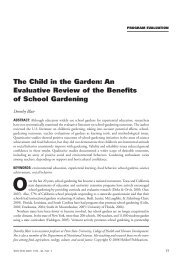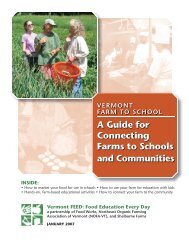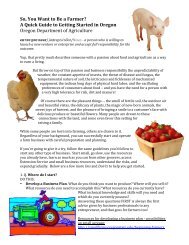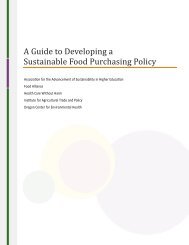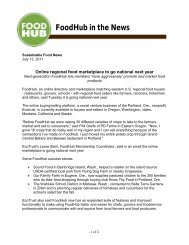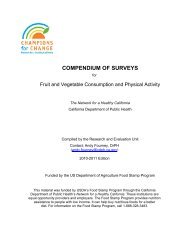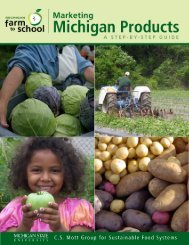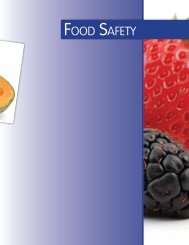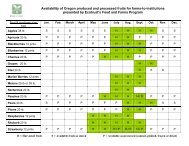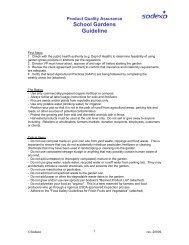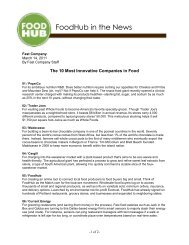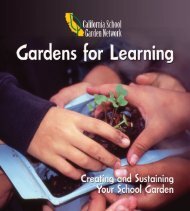eval report cover.indd - New Jersey Farm to School Network Wiki
eval report cover.indd - New Jersey Farm to School Network Wiki
eval report cover.indd - New Jersey Farm to School Network Wiki
You also want an ePaper? Increase the reach of your titles
YUMPU automatically turns print PDFs into web optimized ePapers that Google loves.
►►►►►►►►COM-CA purchased about 6% of produce for its meal programs from localgrowers and about 94% from non-local food distribu<strong>to</strong>rs in 2004-05. However,the local farm purchases all occurred in the last four months of the school year,thus purchases throughout the year would possibly result in a higher percentage.20CON-NH <strong>report</strong>ed that the overall district purchases for local products accountedfor 16% of its budget, which included fresh produce, bakery items,cheese and water. 84Th e Appalachian Sustainable Agriculture Project’s <strong>Farm</strong> <strong>to</strong> <strong>School</strong> program inselect North Carolina schools (ASA-NC) <strong>report</strong>ed that local products accountfor 3-5% of all produce purchased by school districts participating in the farm <strong>to</strong>school program from four counties. 85Bend La-Pine <strong>School</strong> District in Oregon (BLP-OR) <strong>report</strong>ed that its averagespending on local products was $1,500 per week from four farmers, of whichabout $1,200 is spent on fruits and the rest on vegetables. 86For the summer and fall meals served in <strong>New</strong> York City schools in 2005-06,SFP-NY facilitated the local purchases of 87,900 lbs of peaches, 40,700 lbs ofnectarines and 6,600 lbs of pears through the Office of <strong>School</strong> Food distribu<strong>to</strong>rs.81SFP-NY worked with a local manufacturer, Upstate <strong>Farm</strong>s Cooperative, <strong>to</strong> developa 4-oz non-fat yogurt with no artificial colors or flavors. Th e <strong>New</strong> York CityOffice of <strong>School</strong> Food now orders approximately 7,000 cases of locally producedyogurt at a value of $74,000 per month. 81BTV-VT local purchases direct from farmers increased from $0 in 2003 <strong>to</strong>$4,636 in 2006; local purchases through distribu<strong>to</strong>rs increased from $547 in2003 <strong>to</strong> $2,176 in 2006, a 298% increase. 14In the 2006-07 school year, MLS-MT purchased approximately 16,000 lbs ofMontana grown foods, which corresponds <strong>to</strong> 24.4% of all food purchases and$11,990 in income <strong>to</strong> the local economy (up from $4,563 from previous year).Local foods purchased included oats, whole wheat fl o ur, peaches, apples, cantaloupes,carrots, cucumbers, pota<strong>to</strong>es, zucchini, cheese, pasta, honey and saladgreens, with nearly all these products being organically grown. 60Review of <strong>Farm</strong> <strong>to</strong> <strong>School</strong> Evaluation LiteratureChanges in waste management practices►Th e Davis Unified <strong>School</strong> District’s Waste Management Study (DWM-CA) assessedwaste reduction in 2001 linked <strong>to</strong> a farm <strong>to</strong> school program. With datacollected over a one year period, the study estimated gross savings of $6,320in disposal fees from programs at two elementary schools. This estimate didnot include reductions in cus<strong>to</strong>dial staff time and materials, nor did it includeprogram costs, or account for the value of the educational opportunities that theprogram provided <strong>to</strong> students. Th e waste stream at Cesar Chavez Elementarywww.farm<strong>to</strong>school.org 47



